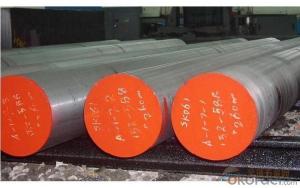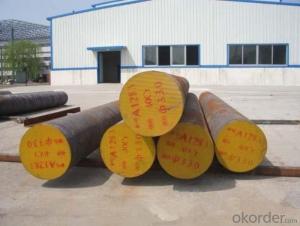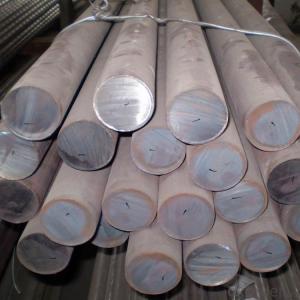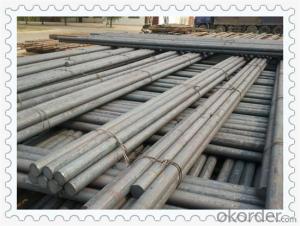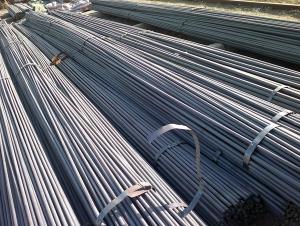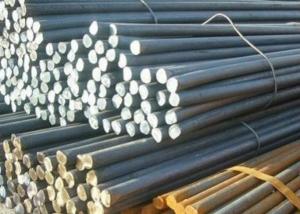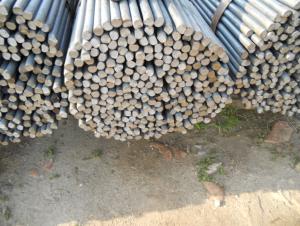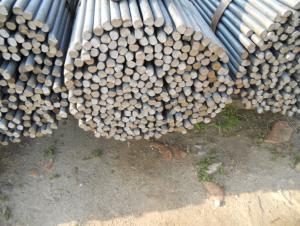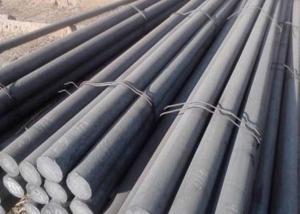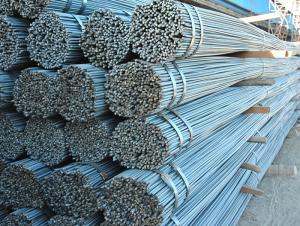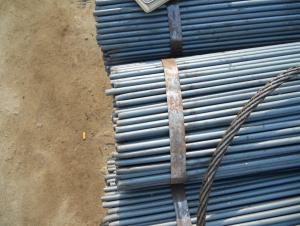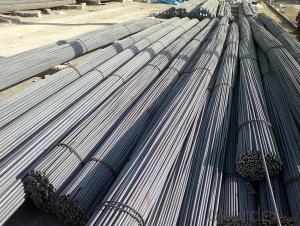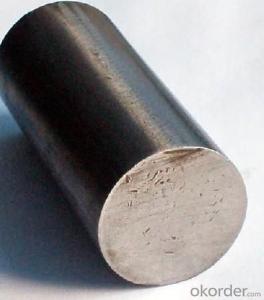Plain Round Bar
- Loading Port:
- China Main Port
- Payment Terms:
- TT OR LC
- Min Order Qty:
- -
- Supply Capability:
- -
OKorder Service Pledge
OKorder Financial Service
You Might Also Like
Specifications of High Quality Round Bar
1. Grade: GB, JIS, ASTM, EN
2. Grade: Q235, SS400, A36, S235JR
3. Diameter and mass: As below
Diameter | Mass | Diameter | Mass | Diameter | Mass |
(mm) | (kg/m) | (mm) | (kg/m) | (mm) | (kg/m) |
6 | 0.22 | 22 | 2.98 | 53 | 17.30 |
7 | 0.30 | 24 | 3.55 | 56 | 19.30 |
8 | 0.40 | 25 | 3.85 | 60 | 22.20 |
9 | 0.50 | 26 | 4.17 | 63 | 24.50 |
10 | 0.62 | 28 | 4.83 | 65 | 26.00 |
11 | 0.75 | 30 | 5.55 | 70 | 30.20 |
12 | 0.89 | 32 | 6.31 | 75 | 34.70 |
13 | 1.04 | 34 | 7.13 | 80 | 39.50 |
14 | 1.21 | 36 | 7.99 | 85 | 44.50 |
15 | 1.39 | 38 | 8.90 | 90 | 49.90 |
16 | 1.58 | 40 | 9.86 | 95 | 55.60 |
17 | 1.78 | 42 | 10.90 | 100 | 61.70 |
18 | 2.00 | 45 | 12.50 | 120 | 88.85 |
19 | 2.23 | 48 | 14.20 | 140 | 120.93 |
20 | 2.47 | 50 | 15.40 | 150 | 138.82 |
4. Material: Mild Steel
5. Heat treatment of high quality steel:
Fire: Isothermal annealing temperature is 800 ~ 880 °C, with 10 ~ 20 °C, the furnace cooling to about 600 °C, hardness above HB269.
Preheat temperature: 730-730 °C
Quenching temperature: 1190-1210 °C
Tempering temperature: 540-595 °C
Cold drawn, hardness 285 HBS
Cold drawn after annealing condition, hardness 277 HBS
Quenching methods: oil quenching, air cooling or salt bath quenching
Usage and Applications of High Quality Round Bar
1) Suitable for making various strong cutting tool abrasion resistance, impact resistance.
2) Used to produce all kinds of high hard and super hard saw blade, drill, tap, broach, gear hob and various kinds of milling cutter.
3) Used for advanced punching die, screw die, and the toughness and complicated shape of the punch, etc.
4) Is used for cold forging die and drawing mode, etc.
5) Recommended watchcase factory, screw factory and other cold stamping products industry use.
Packaging & Delivery of High Quality Round Bar
Packaging Detail: All goods are packed in bundle with steel strips and shipped by break bulk vessel or container (depend on target market and different ports)
Delivery Detail: 45 days
Trade terms: FOB, CFR, CIF
MOQ: 25 tons per specification; we can negotiate the quantity if the specification is normal or we have stock of one specification.
Weight: The price invoicing on theoretical weight basis or actual weight basis depends on customer’s request.
Shipment: The shipment of bulk break or container is depends on customer’s request and the situation of the port of destination.
Documents given: Full set of original clean on board bill of lading; Original signed commercial invoice; Original packing list; Policy of insurance; Certificate of origin and what the target market needs.
Production Flow of High Quality Round Bar
The common processes are preheated forging quenching, dual refinement solution process, cooling quenching and isothermal quenching. We use heat treatment for dual refinement solution process. The main measures process is high temperature solution and refinement cycle. High temperature solution can improve the carbide morphology and particle size. The aim is to make the loop refinement ultrafine austenite grains.
- Q: What is the difference between a bright and a rough turned steel round bar?
- The primary differences between a bright turned steel round bar and a rough turned steel round bar lie in their surface finishes and the precision involved in their manufacturing processes. A bright turned steel round bar boasts a sleek and shiny surface finish. This is achieved by subjecting the bar to supplementary processes such as polishing or grinding after the initial turning operation. The bright surface finish not only enhances the bar's aesthetic appeal but also provides improved resistance against corrosion. Conversely, a rough turned steel round bar exhibits a more textured surface finish. It is typically obtained directly from the turning operation without any additional refining processes. The rough surface finish may display visible tool marks and a slightly uneven texture. Regarding manufacturing precision, a bright turned steel round bar tends to be more accurate and precise in terms of its dimensions and tolerances. The additional processes involved in attaining a bright surface finish also enable tighter control over the bar's specifications. As a result, bright turned bars are suitable for applications where precise dimensions and tolerances are crucial. In contrast, a rough turned steel round bar may have slightly looser tolerances due to the nature of the turning process and the absence of further refining operations. Nevertheless, rough turned bars can still meet the requirements of many applications that do not necessitate high precision. Ultimately, the choice between a bright turned steel round bar and a rough turned steel round bar hinges on the specific application and the desired surface finish and precision.
- Q: How are steel round bars used in the mining industry?
- The mining industry extensively utilizes steel round bars for various purposes. Underground support systems heavily rely on these bars, commonly employed as roof bolts or rock bolts, to prevent cave-ins or roof falls. In the manufacturing of drilling equipment, steel round bars are frequently transformed into drill rods or drill bits. This conversion allows them to endure the challenging conditions associated with mining operations. The bars are typically subjected to heat treatment to enhance hardness and resistance to wear, ensuring their durability during drilling processes. Within the mining field, steel round bars have another significant application in the production of grinding media for grinding mills. Termed grinding rods, these bars consist of high-quality steel and possess specific hardness and toughness. Their function is to effectively reduce ore particles into smaller sizes, facilitating the extraction of valuable minerals. Furthermore, steel round bars contribute to the construction of conveyor systems in mining operations. They are commonly employed as support bars or rollers in conveyor belts, ensuring the efficient transportation of mined materials from one location to another. To summarize, steel round bars hold a crucial position in the mining industry. Their diverse applications, ranging from providing support in underground mines to manufacturing drilling equipment and grinding media, contribute to the overall efficiency and productivity of mining operations.
- Q: What is the typical price range for steel round bars?
- The typical price range for steel round bars varies depending on factors such as size, grade, and market conditions. However, generally speaking, steel round bars can range in price from $0.50 to $10 per pound.
- Q: Can steel round bars be painted?
- Steel round bars can indeed be painted in order to protect them from corrosion and improve their appearance. However, prior to painting, it is crucial to properly prepare the surface of the steel round bars by thoroughly cleaning, degreasing, and eliminating any rust or mill scale. This can be accomplished through various methods such as sandblasting, wire brushing, or chemical cleaning. Once the surface is adequately prepared, it is necessary to apply a primer specifically formulated for steel to enhance the adhesion of the paint. Subsequently, the desired paint can be applied to the steel round bars using brushes, rollers, or spray equipment. It is essential to select a paint that is suitable for outdoor use and offers ample protection against harsh weather conditions. To ensure the long-lasting durability of the painted steel round bars, regular maintenance and periodic repainting may be necessary.
- Q: What are the advantages of using nickel-chromium-aluminum alloy steel round bars?
- Nickel-chromium-aluminum alloy steel round bars offer numerous benefits. Firstly, they possess exceptional corrosion resistance, making them ideal for use in harsh environments or industries where corrosion is a concern. This resistance to corrosion prolongs the lifespan of the round bars, reducing maintenance and replacement expenses. Secondly, these round bars are known for their high strength and durability, making them suitable for applications that involve heavy loads or high temperatures. Their strength also enhances structural stability, making them a dependable option for construction projects and industrial applications. Additionally, this alloy steel demonstrates excellent thermal stability, allowing it to maintain its shape and mechanical properties even under elevated temperatures. This attribute is particularly advantageous in industries such as aerospace, automotive, and power generation, where high temperatures are prevalent. Furthermore, nickel-chromium-aluminum alloy steel round bars offer good formability and machinability, facilitating easy fabrication and customization. This versatility allows for the production of intricate shapes and designs, making them adaptable for various manufacturing processes. Lastly, this alloy steel is recognized for its resistance to oxidation and scaling at high temperatures. This makes it suitable for applications involving exposure to extreme heat or rapid temperature changes, such as in furnaces or heat exchangers. In conclusion, the benefits of utilizing nickel-chromium-aluminum alloy steel round bars include exceptional corrosion resistance, high strength and durability, thermal stability, formability, and resistance to oxidation. These qualities make it a preferred choice for a wide range of industries, ensuring reliable performance and longevity in various applications.
- Q: What are the weight calculations for steel round bars?
- The weight calculations for steel round bars can be determined using a straightforward formula. The weight of a steel round bar can be calculated by multiplying the square of the diameter in millimeters by the length in meters and then multiplying the result by the specific weight of steel, which is typically around 7.85 grams per cubic centimeter. The formula for calculating the weight of a steel round bar is as follows: Weight = (Diameter^2 x Length x Specific Weight of Steel) / 1000 Where: - Diameter is the diameter of the round bar in millimeters - Length is the length of the round bar in meters - Specific Weight of Steel is the density of steel, which is usually 7.85 grams per cubic centimeter - 1000 is used to convert the weight from grams to kilograms It is important to note that this formula assumes the round bar is made of pure steel and does not account for any variations in the specific weight of different steel alloys. Additionally, it is crucial to use consistent units throughout the calculation, either millimeters or meters, to obtain accurate results.
- Q: Can steel round bars be used for making axles?
- Yes, steel round bars can be used for making axles. Steel is a strong and durable material that is commonly used for axles due to its high tensile strength and ability to withstand heavy loads and stress. Round bars provide a suitable shape for axles as they offer good structural integrity and can be easily machined and manipulated to meet specific axle requirements.
- Q: What are the main differences between wrought round steel, hot rolled round steel and cold drawn round steel? Where are they used separately?
- Round steel three processing methods are more common, should be very wide surface. Hot rolled round steel, used in construction and general hardware parts processing is very common.
- Q: Can steel round bars be hardened and tempered?
- Yes, steel round bars can be hardened and tempered. Hardening and tempering are heat treatment processes used to increase the hardness and strength of steel. To harden a steel round bar, it is heated to a high temperature and then rapidly cooled, typically by quenching in water, oil, or air. This process transforms the steel's structure, making it harder and more brittle. Once the steel round bar has been hardened, it is often too brittle for many applications. To reduce the brittleness and improve its toughness, the hardened steel is then tempered. Tempering involves reheating the steel to a specific temperature and holding it at that temperature for a specified time before allowing it to cool naturally. This process allows the steel to partially soften and relieve internal stresses, making it tougher and more ductile. The hardness and tempering temperature can be adjusted to achieve the desired mechanical properties for different applications. The hardening and tempering process can be used to produce steel round bars with varying levels of hardness, strength, and toughness to suit specific engineering requirements.
- Q: What are the different types of steel alloy compositions used for round bars?
- Round bars are made from various steel alloy compositions, each with its own unique properties and applications. Some commonly used compositions include carbon steel, alloy steel, stainless steel, tool steel, duplex steel, and high-speed steel. Carbon steel is the basic and widely used type, consisting primarily of iron and carbon. It is known for its strength, durability, and affordability. Alloy steel, on the other hand, contains additional alloying elements like manganese, chromium, nickel, or molybdenum. This gives it enhanced strength, hardness, and resistance to wear, making it suitable for high-performance applications. Stainless steel, composed mainly of iron, chromium, and nickel, offers excellent corrosion resistance. It is ideal for environments with high moisture or chemical exposure, and it is often used in architectural and decorative applications. Tool steel is designed for exceptional hardness, toughness, and wear resistance. It is commonly used in the production of cutting tools, dies, and molds. Elements like tungsten, vanadium, or cobalt are added to enhance its performance. Duplex steel is a balanced combination of austenitic and ferritic microstructures. It provides excellent strength and corrosion resistance, making it suitable for demanding environments like the offshore oil and gas industry. High-speed steel is engineered to withstand high temperatures and maintain hardness and toughness at elevated speeds. It is frequently used in the production of cutting tools, drills, and milling cutters. Compositions containing elements like tungsten, molybdenum, or cobalt are typically used. These examples represent just a few of the steel alloy compositions available for round bars. The choice of composition depends on the specific application, desired properties, and performance requirements.
Send your message to us
Plain Round Bar
- Loading Port:
- China Main Port
- Payment Terms:
- TT OR LC
- Min Order Qty:
- -
- Supply Capability:
- -
OKorder Service Pledge
OKorder Financial Service
Similar products
Hot products
Hot Searches
Related keywords







